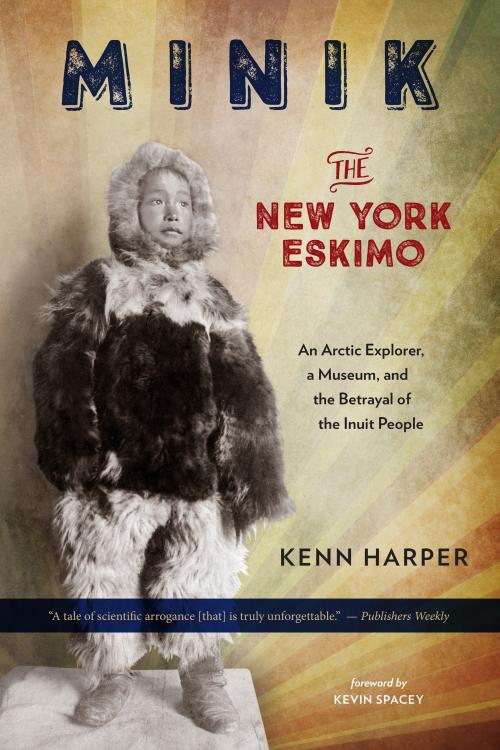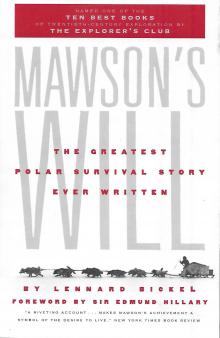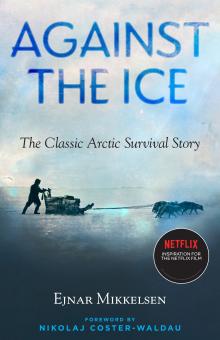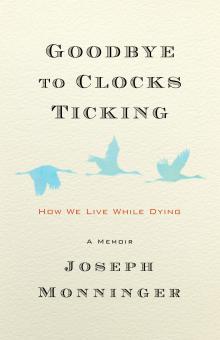Excerpt
Robert Peary’s chartered ship, the Hope, a three-masted sealer, had made a brief stop for fuel in Sydney on the northern tip of Nova Scotia. Now, heavy in the water on the last day of September, 1897, she was gliding past the Statue of Liberty and heading toward the East River, where she would soon be fast to Excursion Wharf at the foot of Dock Street in Brooklyn.
From Sydney, Peary had wired New York the news of the ship’s imminent arrival, and the city’s newspapers were only too pleased to print it.
Robert Peary needed no introduction to reporters or the American public. A seasoned explorer, his adventures had been reported to an eager public for a decade. He had made sure that his expeditions were well covered in the press, for he depended on favorable publicity for his funding and ultimately for his success. This last foray had been a summer excursion to Greenland.
Peary had been to Greenland before—that was hardly news anymore. But what set the city abuzz this time was news of the cargo he carried: a large meteorite and six Inuit—“Eskimos” to the curious people of New York—as well as the sealskins, furs, kayaks, and harpoons they brought with them, all tools and clothing that New Yorkers would find exotic.
As the vessel drew close to the Brooklyn Bridge, the Inuit, “curious, long-haired individuals, clad in furs and skins,” were on deck, awed by the sight of the city’s skyline. Suddenly they began to gesticulate wildly. The closer the ship came to the bridge, the more animated their gestures became, as if they, and they alone, knew some disaster was imminent. In fact they were vainly trying to warn the captain that the topmast would surely be knocked off if he tried to pass under the bridge. The Inuit were concerned; the crew and the few passengers aboard were amused. The Inuit had had their first taste of the wonders of the city.
The following day twenty thousand people showed up in Brooklyn to see the ship and, for the first time, real live Inuit who hailed from Smith Sound in the northwestern corner of Greenland. Of equal interest was the enormous meteorite that Peary had brought back; over the course of a few years it had been wrenched from the frozen ground and hauled a mile to the shore before being laboriously loaded onto the ship.
Authorities had expected there to be crowds upon the Hope’s arrival. To bring some semblance of order they granted admission by ticket only.
Three days later, on October 3, the Hope was moving again as tugs towed the vessel to the nearby Brooklyn Navy Yard, where the public’s enthusiasm continued. The meteorite was lifted by derrick from the ship and nestled into a huge timber platform on land. As many as a thousand people a day would come to view it.
“The crowd afterward boarded the vessel to see the Eskimos, who had attired themselves in their native costumes for inspection,” The New York Times reported. The writer mentioned two Inuit children in particular, a girl, Aviaq, and a boy, Minik, and said they “attracted considerable attention, and were plentifully supplied with candy and peanuts, which they seemed to enjoy immensely.”
A ship’s officer was quoted as saying, “The children are sick from the quantity of sweet things given them. We feed them with raw meat, and the candy has had a bad effect on them.”
To the little group of Inuit, these throngs of New Yorkers were overwhelming. Thirty thousand visitors in two days alone! Peary had told them that many people lived in America, but so many? The Inuit had grown accustomed to seeing strange new faces when the occasional ship from afar arrived at their Greenland settlements, but no amount of prepping by Peary could have prepared them for this turnout. Their own tribe back in Smith Sound, indeed their whole world, numbered fewer than 250 people. Peary had promised they would be safe. Now they were seeing, for the first time, a city skyline and street traffic and the human masses of New York, in all colors, shapes, and style of dress. The experience was as unsettling as it was exciting. The Inuit would quickly learn that they were completely dependent on Peary and those who did his bidding.
Why had Peary brought six Inuit—three men, a woman, and two children—to New York? Was it a selfless gesture, a way to reward those who had served him so loyally during his earlier adventures in Greenland, as he would maintain? Or was there something sinister in this? Could he not have imagined that there might be unfortunate consequences from taking Inuit from their homeland and abandoning them in New York City?
In short, what kind of man would take such liberties with the lives of other people? Who, exactly, was Robert Peary?
Robert Edwin Peary was born into a poor family in Pennsylvania in 1856. When he was not yet three, his father died of pneumonia at the young age of thirty. Robert’s mother promptly packed up her son and returned with her husband’s body to the family’s native Maine, settling near Portland. She never remarried, and young Robert would remain an only child. Though of limited means, she doted on the boy she called Bertie. A mama’s boy whom she pampered and indulged, he was raised for a time as if he were a girl. Indeed, his own daughter would eventually write, “Gentle, pious Mary Peary had no previous experience with small children, especially small boys. . . . She tried her best to make her son over into the gentle little girl whom she would have known so well how to handle. She tried to implant in him the idea that he was not strong, that he was too delicate to play with other boys.”
The boy was also hampered by a pronounced lisp, which he worked steadfastly to overcome before he reached adulthood. Mrs. Peary sent him to a succession of boarding schools, making sure that she always moved to a community quite nearby. In high school, perhaps as a form of rebellion against his mother’s dominance, he took up outdoor activities, although he never liked team sports. He also became an expert in taxidermy and ornithology.
In 1873 Peary enrolled in Bowdoin College in Brunswick, Maine, on a scholarship, and his mother again relocated to be close by. After four years he graduated as a civil engineer. In 1879 he found employment with the Coast and Geodetic Survey in Washington. He found the city stimulating but the work boring—he was merely a draftsman occupying a desk and dreaming of greater glory, for he was nothing if not ambitious.
Peary applied for a position as civil engineer with the US Navy in 1881. The job appealed to him because it came with the rank of lieutenant and the prestige that accompanied that rank. He had earlier written to his mother: “. . . I cannot bear to associate with people, who, age and advantages being equal, are my superiors. I must be the peer or superior of those about me to be comfortable. . . .” The naval position would put him in the company of people who would notice his abilities and drive, and place him on the path of advancement. In the same letter, written when he was twenty-four, he outlined for his mother an ambitious and arrogant description of how he saw himself by age thirty:
Tall, erect, broad-shouldered, full-chested, tough, wiry-limbed, clear-eyed, full-mustached, clear-browed complexion, a dead shot, a powerful, tireless swimmer, a first-class rider, a skillful boxer and fencer, perfectly at home in any company, yet always bearing with me an indefinable atmosphere of the wildness and freedom of woods and mountains, master of German, Spanish, and French. . . .
Peary excelled at his work with the navy. In early 1882 he was sent to the US Naval Station at Key West, Florida, as an inspector to oversee the work of a contractor on the construction of a new pier. The contractor botched the job; Peary canceled the contract and oversaw the completion of the project himself, which he brought in under budget.
By 1884 he was in Nicaragua on the first of two trips there to survey a possible route for a transoceanic canal from the Atlantic to the Pacific. On both trips he served under the authority of a senior naval civil engineer. In 1887 and 1888 Peary served seven months there, and effectively laid out the route of the proposed canal. But back in the United States most of the accolades went to the senior engineer, whom Peary came to detest as a result. He resolved that from thence onward he must always be in command.
In between the two trips to Nicaragua, Peary turned his attention northward. In 1886 he took passage on a whaler, the Eagle, to Disko Bay, midway up the west coast of Greenland. From the Danish colony of Ritenbenk, accompanied by one other white man and using man-hauled sleds, he traveled onto the icecap and penetrated into the interior about a hundred miles. The expedition didn’t accomplish much, but he returned alive and published an account of the adventure, which brought him attention. It resulted in his election to the American Association for the Advancement of Science, and enhanced his reputation in Washington society. These were important first steps on his road to influence.
Immediately on his return from Nicaragua, Peary married Josephine Diebitsch, whose father was a scholar at the Smithsonian Institution. Peary’s mother accompanied them on their honeymoon.
He longed for fame and recognition. At one point he wrote to his mother, “Remember, Mother, I must have fame.” He decided that it lay in the north, in Greenland. He contemplated a return to the central west coast and a complete west-to-east crossing of the ice cap. But then news came that a Norwegian, Fridtjof Nansen, had made a successful crossing in the opposite direction. Undeterred, Peary decided that his future lay even farther north. He would determine the outline of the northern coastline of Greenland, in effect proving its insularity.
Some self-promotion would be required to pull this off and secure the requisite support. And so in 1890 he lectured before scientific institutions in Brooklyn and Philadelphia, and the prestigious American Geographical Society in New York. All three institutions voted their support for his proposed expedition, and this helped him secure his leave of absence from the navy. Thus had begun Robert Peary’s eighteen-year involvement with northwestern Greenland and the Polar Eskimos.





